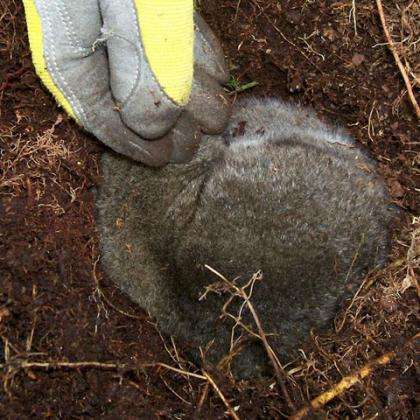Primate hibernation more common than previously thought

(Â鶹ÒùÔº) —Until recently, the only primate known to hibernate as a survival strategy was a creature called the western fat-tailed dwarf lemur, a tropical tree-dweller from the African island of Madagascar.
But it turns out this hibernating lemur isn't alone. In a study appearing May 2 in the journal Scientific Reports, researchers report that two other little-known lemurs—Crossley's dwarf lemur and Sibree's dwarf lemur—burrow into the soft, spongy rainforest floor in the eastern part of Madagascar, curl up and spend the next three to seven months snoozing underground.
By comparing the hibernation habits of eastern dwarf lemurs and their western counterparts, researchers hope to shed light on what sends hibernating animals into standby mode, and whether lemurs—our closest genetic relatives known to hibernate—do it differently from other hibernating animals.
"Exactly what triggers hibernation is still an open question," said lead author Marina Blanco a postdoctoral researcher at the Duke Lemur Center.
Unlike animals such as bears and ground squirrels, which hibernate to survive the cold, western dwarf lemurs hibernate to survive during western Madagascar's long dry season—a time when temperatures top 85 degrees, trees drop their leaves and food and water are in short supply.
But the hibernation habits of Madagascar's eastern dwarf lemurs, whose homes include high-altitude forests where winter temperatures occasionally dip below freezing, were poorly known.
"It's a very different environment," Blanco said.
To find out more, Blanco and her colleagues trapped and fitted the squirrel-sized animals with temperature-sensitive radio collars before the start of the hibernation season, allowing them to find the lemurs' underground burrows and monitor their body temperature once hibernation began.
Hibernating animals tend to breathe more slowly, drop their heart rate and lower their body temperature, becoming inactive for days at a time. Dwarf lemurs are no exception.
"To the casual observer, it looks for all the world as if the animals are dead. Their bodies are cold, they are utterly still and they take a breath only once every several minutes or so," said co-author Anne Yoder, director of the Duke Lemur Center.
Western dwarf lemurs hibernate in drafty tree holes, where their body temperature fluctuates by as much as 20 degrees with the outside air. But the researchers found that eastern dwarf lemurs keep their body temperatures more constant in cozy underground burrows.
The research suggests that lemur hibernation—and therefore primate hibernation—may not be so different after all. "Maybe these lemurs, though they live in the tropics, look more like temperate hibernators than we thought," Blanco said.
More information: "Underground Hibernation in a Primate," Marina Blanco, Kathrin Dausmann, Jean Ranaivoarisoa and Anne D. Yoder. Scientific Reports, May 2, 2013.
Journal information: Scientific Reports
Provided by Duke University




















